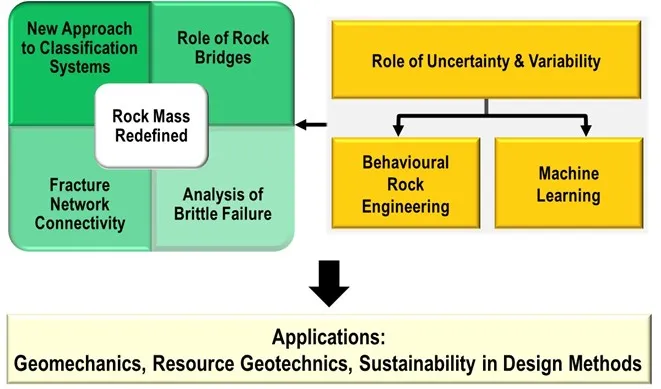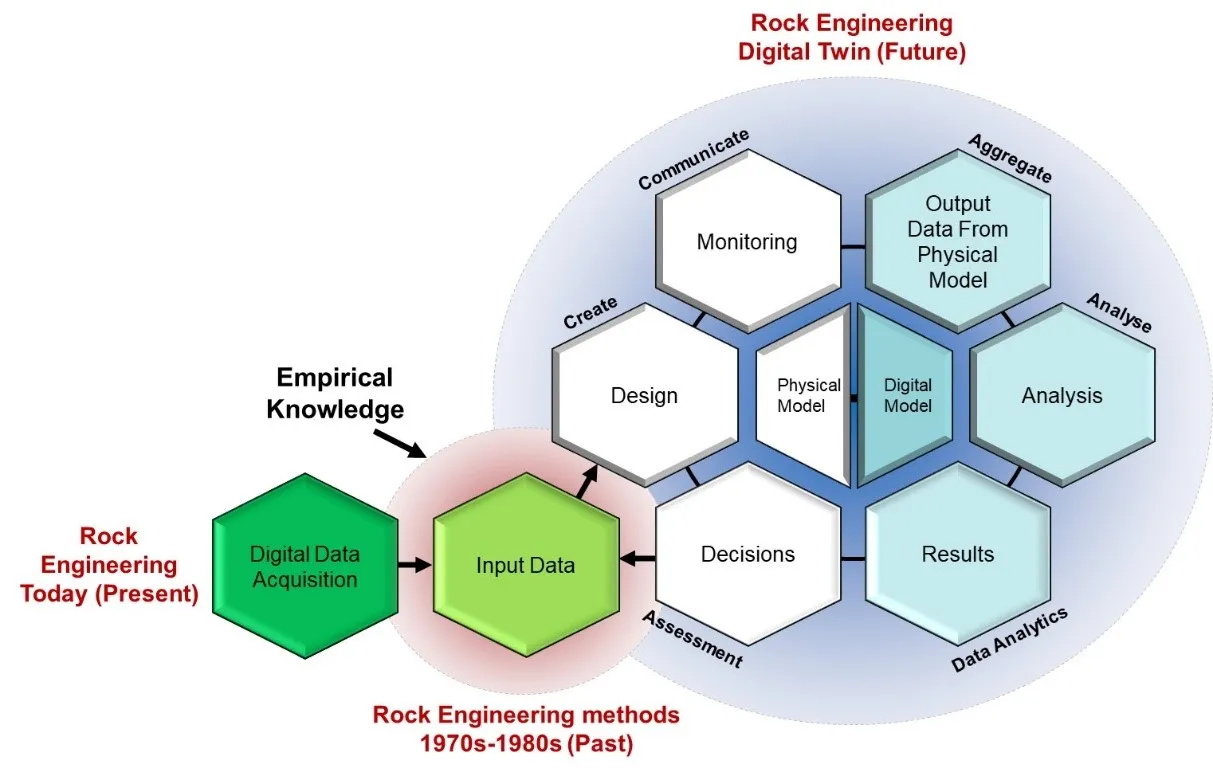
Rock Engineering still heavily relies on empirical systems to:
- Identify significant parameters influencing rock mass behaviour.
- Derive (semi-) quantitative data for engineering design.
- Provide a quantitative measure to compare geological conditions at different sites.
Like a habit, the use of those empirical systems has settled over time, and it has become a regular tendency or practice, hard to give up. A new approach to rock engineering (Figure 1) is required if we want to disrupt “industry standards” that dates back to empirical methods developed in the 1960s and 1970s, and that are clearly not applicable to today’s challenges imposed by deep underground mining in mostly massive and veined orebodies. There is the need to advance and update rock mass classification systems, removing qualitative measurements, and focusing on the use of new technologies to acquire larger and better-quality datasets of key geological parameters that are more appropriate for statistical analysis. This is a key requirement if we want rock engineering to evolve and to support modern design frameworks, including analysis of probability of failure and risk assessment, and use of machine learning algorithms.

The variability of the parameters we use to describe rock engineering parameters (e.g., natural discontinuities) is a manifestation of the randomness of natural geological processes. We need to reduce uncertainty (i.e., increase our knowledge) to capture the true variability of a parameter; note that knowing that a given parameter does not vary is still considered a measurement of its variability. Variability does not exclude uncertainty; to better help in understanding this process, we will in the following two Sections discuss two important concepts:
- There is the need to consider the role of unknown uncertainty, which resides outside our state of knowledge and therefore cannot be captured in statistical models; and
- Engineers generally assume that variability can be described using statistical models; however, this may not be true depending on the level of measurements used to collect the data.
Note that cognitive biases (behavioural rock engineering), which reflect a perceived state of knowledge, affect our understanding of uncertainty and variability.
The future of rock engineering
When using a rock mass classification systems emphasis should be placed on the parameters influencing rock mass behaviour rather than the overall rock mass quality rating itself. Ideally, the rating should always be accompanied by a systematic geological description to permit a comprehensive comparison between conditions at different sites, even in the presence of equivalent classification ratings. This discussion has significant implications for the adoption of machine learning techniques in rock engineering design. Machine learning is not supposed to code geological observations into precise numbers, rather it provides a method to compare geological patterns. There is the need to find a balance between engineering judgments (source of cognitive bias, as discussed in the following section) and quantification of rock mass parameters to be used as training and validation data by machine learning algorithms. The challenge is to address the irreversibility problem of rock mass classification systems and develop algorithms capable of interpreting instances in which different qualitative assessments may be transformed into the same quantitative measurement, and whether such instances are geologically valid. We need to bridge the present and the future of rock engineering by closing the empirical knowledge gap (Figure 2).

References
The role of behavioural factors and cognitive biases in rock engineering
Elmo D. and Stead D.
Published in Rock Mechanics and Rock Engineering (2021).
doi-org.ezproxy.library.ubc.ca/10.1007/s00603-021-02385-3
rdcu.be/cfiay
Can new technologies shake the empirical foundations of rock engineering?
Elmo D., Stead D., Yang B., Tsai R. and Fogel Y.
Proceedings of the Second International Conference on Underground Mining Technology, Australian Centre for Geomechanics, Perth, pp. 107-116.
Open access at doi.org/10.36487/ACG_repo/2035_01
Disrupting rock engineering concepts: is there such a thing as a rock mass digital twin and are machines capable of learning rock mechanics?
Elmo D. and Stead D.
Proceedings of the 2020 International Symposium on Slope Stability in Open Pit Mining and Civil Engineering, Australian Centre for Geomechanics, Perth, pp. 565-576.
Open access at doi.org/10.36487/ACG_repo/2025_34


